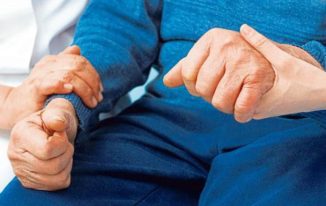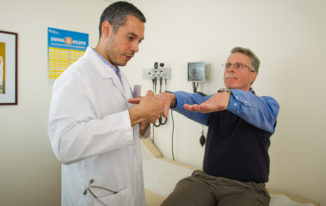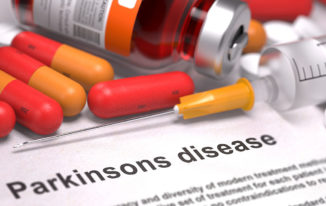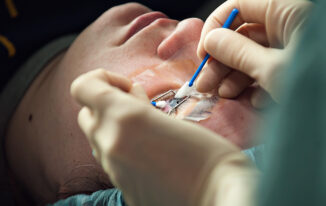Parkinson’s disease is the second most common neurological disorder. It affects the way a person moves. It is characterized by slow and gradual loss of muscle control, which in turn leads to trembling of the limbs and head while at rest, stiffness, slowness, and impaired balance. This is due to problem with certain nerve cells in the brain.
Usually, these nerve cells produce an important chemical called dopamine. Dopamine sends signals to the part of the brain that controls movement. It lets the muscles move smoothly that enables a person to do what he wants to do. In an individual with Parkinson’s, these nerve cells break down. Then there is a lack of dopamine which leads to trouble in moving.
Parkinson’s disease is progressive. That means it gets worse over time. But degree of impairment varies from individual to individual. Usually this happens slowly, over many years. And there are good treatments that can help one live a full life.
What causes Parkinson’s disease?
As yet it is not sure what makes these nerve cells that produce dopamine break down. But scientists are doing a lot of research to look for the answer. Genetic and pathological studies reveal that various dysfunctional cellular processes, inflammation, and stress can all contribute to cell damage.
Researchers suggest that a combination of both genetic and environmental factors cause about 90% of all Parkinson’s disease.
What are the Symptoms of Parkinson’s Disease?
The primary symptoms of Parkinson’s disease are related to voluntary and involuntary motor function and usually start on one side of the body. Symptoms are mild at first and will progress over time. Some individuals are more affected than others. Studies have shown that by the time the primary symptoms appear, individuals with Parkinson’s disease will have lost 60% to 80% or more of the dopamine-producing cells in the brain.
The primary symptoms of Parkinson’s are:
-
Tremor
Tremor means shaking or trembling. It might be the first symptom that an individual notices. It’s one of the most common signs of the disease, although not everyone has it. More importantly, not everyone with a tremor has Parkinson’s disease. It usually affects one side of the body (hand, foot, arm, or other body part). It may be worse when a person is awake but not moving the affected arm or leg. It may get better when you move the limb or you are asleep.
-
Stiff Muscles
The second symptom is rigidity, or resistance to movement. Stiffness of the limbs and trunk may increase during movement. The person has difficulty moving from a sitting to a standing position. Rigidity may produce muscle aches and pain. One sign of Parkinson’s disease is that one arm may not swing back and forth normally when the person walks.
-
Bradykinesia or Slow Movement
The third symptom of Parkinson’s is bradykinesia, or slowness, and small movements. It is seen in people that have small handwriting (micrographia) and no change in facial expression (the person often only has a somber or serious expression). This state is known as “masked face.”
-
Impaired Balance
As Parkinson’s disease progresses, other symptoms related to muscles and movement may develop. Patients may develop a poor posture (stooped posture) with drooping shoulders, feet shuffling, absent arm swing and the head extended or jutting forward. This often leads to difficulty in balancing. Individuals may freeze in mid-stride and appear to fall forward while walking.
Secondary Symptoms of Parkinson’s
While the primary symptoms of Parkinson’s disease are movement-related, progressive loss of muscle control, continued damage to the brain can lead to secondary symptoms. These vary in severity, and not every individual will experience all of them. Some of the secondary symptoms include:
- Anxiety, insecurity, and stress
- Confusion, memory loss, and dementia
- Constipation
- Depression
- Difficulty in sleeping and fatigue
- Oily skin and dandruff
- Difficulty in swallowing and excessive salivation
- Diminished sense of smell
- Increased sweating
- Male erectile dysfunction
- Skin problems
- Slowed, quieter speech, and monotone voice
- Urinary frequency/urgency
How is Parkinson’s disease diagnosed?
A neurologist who specializes in movement disorders will be able to make the most accurate diagnosis. An initial assessment is made based on medical history, a neurological exam, and the symptoms present. For the medical history, it is important to know whether other family members have Parkinson’s disease, what types of medication have been or are being taken, and whether there was exposure to toxins or repeated head trauma in the past. A neurological exam may include an evaluation of coordination, walking, and fine motor tasks involving the hands.
The main things the neurologist will look for are a tremor at rest and rigidity (involuntary). He will frequently check the response to an unanticipated pull from behind. He will tell what will happen and will protect the person from a fall as he checks the ability to recover the balance.
There is no ultimate test for the disease except for a biopsy of specific brain tissue that is only usually done at autopsy. Other tests (CT scan, MRI) may be used to help neurologist distinguish between Parkinson’s disease and other problems such as stroke and tumor.
Who is at risk for Parkinson’s disease?
- Age is the prime risk factor for the development and progression of Parkinson’s disease. Most people who develop Parkinson’s disease are older than 60 years of age.
- Men are affected about 1.5 to 2 times more often than women.
- A small number of individuals are at increased risk because of a family history of the disorder.
- Head trauma, illness, or exposure to environmental toxins such as pesticides and herbicides may be a risk factor.
What is the treatment for Parkinson’s disease?
Presently there is no treatment to cure Parkinson’s disease. Several therapies are available to delay the beginning of motor symptoms and to improve motor symptoms. All of these therapies are designed to increase the amount of dopamine in the brain either by replacing dopamine, mimicking dopamine, or prolonging the effect of dopamine by inhibiting its breakdown. Studies have shown that early therapy in the non-motor stage can delay the onset of motor symptoms, thereby extending quality of life.
1. Levodopa, in the form of carbidopa and levodopa combined in a single tablet is the most effective medication to reduce or temporarily stop Parkinson’s disease symptoms. The brain tissue converts this drug to dopamine. However, over time the suggestive reduction caused by the drug starts to fade and higher doses and other medications may be added. In addition, side effects of levodopa may develop nausea, vomiting, mental changes, and involuntary movements).
2. Dopamine Agonists: Although carbidopa-levodopa is the usual first-choice drug to treat Parkinson’s disease, other drugs that mimic the action of dopamine, called dopamine agonists, may be used when the effects of carbidopa-levodopa fade. Such drugs as Apokyn, Mirapex, Parlodel, and Requip are used. These drugs have side effects similar to carbidopa-levodopa, for example, nausea, vomiting, and psychosis.
3. Other Medications: Some drugs are used in combination with carbidopa-levodopa to either inhibit dopamine breakdown by the body or to improve the efficacy of carbidopa-levodopa. Azilect, Eldepryl,and Zelapar inhibit dopamine breakdown while Entacapone and Tasmar can improve the effect of carbidopa-levodopa.
4. For some individuals with advanced, virtually unmanageable motor symptoms, surgery may be an option. In Deep Brain Stimulation(DBS), the surgeon implants electrodes to stimulate areas of the brain involved in movement. In another type of surgery, specific areas in the brain that cause Parkinson’s symptoms are removed or destroyed. The techniques are termed pallidotomy and subthalamotomy.
5. In addition to medication and surgery, general lifestyle changes, well balanced-diet, rest and exercise, physical therapy, occupational therapy, and speech therapy may be beneficial.
Do not take any medicine or treatment without consulting a neurologist. You can easily find a neurologist in Bangalore on search engines and can get easily connected with them.
How to cope with Parkinson’s disease?
Though Parkinson’s disease progresses slowly, it ultimately affects every aspect of life – from social engagements, work, to basic routines. Accepting the gradual loss of independence can be difficult. Being well informed about the disease can reduce anxiety about what lies ahead.
As soon as you notice symptoms of any Parkinson’s, immediately get in touch with a neurologist. There are very famous and experienced neurologists in Bangalore who will guide you in a proper way and will give you the treatment as per your condition.












Great write-up, Sonal! And the good news is – soon it may be possible to stop the progression of Parkinson’s disease with a simple medicine. Hope this works out soon so that millions of people will get benefit out of it.
I hope it works out soon Ben!
Thank You, mam, For this well-written article on Parkinson’s disease, I was really searching for this type of article in simple language. My all misconception about this neurological disorder has been sorted.
Glad that you liked it Umesh!
Hi Sonal,
It’s great to read your post. I was busy with my projects, that’s the reason I was inactive a bit, specially reading & commenting was completely off.
But Anyways, Thanks for the interesting & informative read. Keep up the good work and enjoy the holidays.
A Very Happy New Year Sonal! Cheers
~ Donna
Wish you a very Happy New Year Donna!!
Good information here, Sonal. Two of my relatives have the same symptoms that’s why I keep reading about this illness. Thanks for making it understandable. I also read somewhere that there is a new invention to control this involuntary movements, I hope it will be available soon, it will really be a great relief to both family and the patient. Thanks for sharing!
Glad to know that you found the post useful!